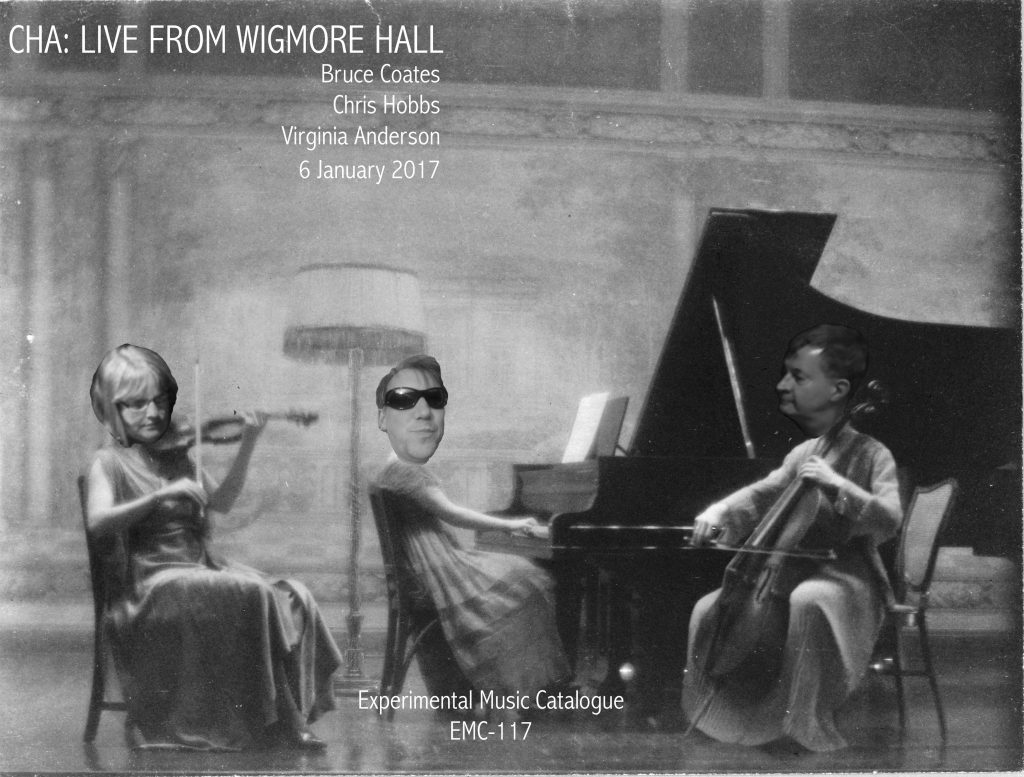The EMC² Weekend at De Montfort University, Leicester, was a great success, with talks, concerts, and a chance for all to perform great music in the tradition of the Experimental Music Catalogue. This weekend was the brainchild of Kieran O’Riordan, with Anna Claydon of CoMA (Contemporary Music for All), and performed with energy and much skill by the members of East Midlands CoMA, the improvisation groups CHA (Bruce Coates, Chris Hobbs, Virginia Anderson) and the South Leicestershire Improvisors Ensemble (Lee Allatson, Rick Nance, Virginia Anderson, Bruce Coates and Chris Hobbs), guest expert composers and performers including John White, Hugh Shrapnel, Sarah Walker, Chris Hobbs, Virginia Anderson, and Bruce Coates. Papers were given on related subjects from Virginia Anderson, Hilary Bracefield and Tim Bausch. Much material has been created from this event; much needs to be sifted, edited, and collated for publication. But we would like to share a little taste of the event as it went on:
Friday, 24 March:
Schedule:
Session 1: Setting the Scene
1.45 pm: Virginia Anderson, “The Experimental Music Catalogue: Past, Present, and Future”
Recording of live feed:
The Experimental Music Catalogue
Публикувахте от LUST в Петък, 24 март 2017 г.
Rehearsals and tea, then
4.45pm: Hilary Bracefield, “From Birmingham to Belfast: Improvising and experimenting with students”
(talk notes above for abstract and bio)
Recording of live feed:
Hilary Bracefield, ‘From Birmingham to Belfast: improvising and experimenting with students’
Публикувахте от Experimental Music Catalogue в Петък, 24 март 2017 г.
Evening concert, MTI Goes EMC²: Students and staff from DMU’s music technology department play music.
Saturday, 25 March:
Began with rehearsals for allcomers and tea, then lunch, then:
1.30 pm: Panel chaired by Sarah Walker, including Virginia Anderson, Chris Hobbs, John White and Hugh Shrapnel
Recording of live feed:
Panel Chaired by Sarah Walker, including Virginia Anderson, Chris Hobbs, John White and Hugh Shrapnel.
Публикувахте от Experimental Music Catalogue в Събота, 25 март 2017 г.
2.30: Concert 2: Keyboard Experiments
Programme:
Video awaiting processing, so we’ll have to wait for good quality clips, and for Howard Skempton’s In Tandem, performed by Antony Clare and Mick Peake.
However here are links to very short clips:
Chris Hobbs, premiere of solo version of Sudoku 82:
We're hoping to bring you not only the talking portion of the EMC2 weekend, but also audio and perhaps video records of these historic concerts. In the meantime, here are a few clips from the lunchtime Keyboard Experiments concert: first, a few seconds of Chris Hobbs, premiering the first solo version of his Cold Blue Sudoku 82.
Публикувахте от Experimental Music Catalogue в Неделя, 26 март 2017 г.
Hugh Shrapnel and Sarah Walker, playing Hugh Shrapnel, Ladywell Station
We're hoping to bring you not only the talking portion of the EMC2 weekend, but also audio and perhaps video records of these historic concerts. In the meantime, here are a few clips from the lunchtime Keyboard Experiments concert: Here is Hugh Shrapnel and Sarah Walker performing Hugh's Ladywell Station.
Публикувахте от Experimental Music Catalogue в Неделя, 26 март 2017 г.
Hugh Shrapnel, Cat Preludes, “…and mouse”, performed by Sarah Walker:
We're hoping to bring you not only the talking portion of the EMC2 weekend, but also audio and perhaps video records of these historic concerts. In the meantime, here are a few clips from the lunchtime Keyboard Experiments concert: Sarah Walker playing "…and mouse" from Hugh Shrapnel's Cat Preludes.
Публикувахте от Experimental Music Catalogue в Неделя, 26 март 2017 г.
Also “Asleep”, from Cat Preludes
Here is Shrapnel playing his Nocturne:
We're hoping to bring you not only the talking portion of the EMC2 weekend, but also audio and perhaps video records of these historic concerts. In the meantime, here are a few clips from the lunchtime Keyboard Experiments concert: Hugh Shrapnel playing his Nocturne.
Публикувахте от Experimental Music Catalogue в Неделя, 26 март 2017 г.
Chris Hobbs, with Terry Jennings’ Winter Trees:
We're hoping to bring you not only the talking portion of the EMC2 weekend, but also audio and perhaps video records of these historic concerts. In the meantime, here are a few clips from the lunchtime Keyboard Experiments concert: Chris Hobbs performing Terry Jennings' Winter Trees.
Публикувахте от Experimental Music Catalogue в Неделя, 26 март 2017 г.
and John White, here playing most of Sonata 159, “Waiting for Batman”:
We're hoping to bring you not only the talking portion of the EMC2 weekend, but also audio and perhaps video records of these historic concerts. In the meantime, here are a few clips from the lunchtime Keyboard Experiments concert: John White performing his 2007 Piano Sonata 159, "Waiting for Batman".
Публикувахте от Experimental Music Catalogue в Неделя, 26 март 2017 г.
At 5 pm (after more rehearsals), Tim Bausch gave a paper, “Repetition as Catalyst: The Process of Creation in the Music of Alvin Lucier.”
Tim Bausch, ‘Repetition as Catalyst: The Process of Creation in the Music of Alvin Lucier’
Публикувахте от Experimental Music Catalogue в Събота, 25 март 2017 г.
We will get to the evening concert, Continuing Experiments, in another post.






